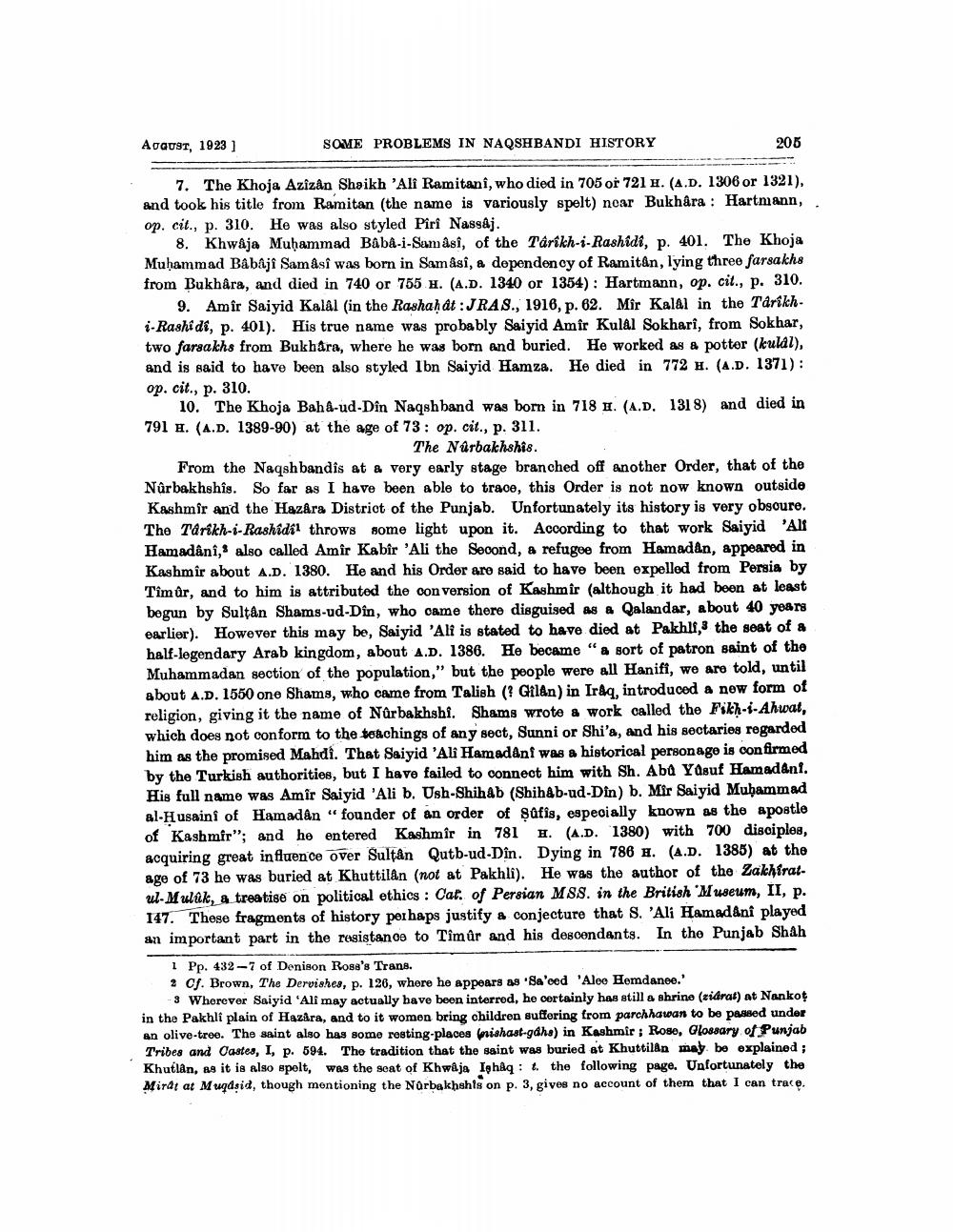________________
AVQUST, 1923 ]
SOME PROBLEMS IN NAQSHBANDI HISTORY
205
7. The Khoja Azizan Shạikh 'Ali Ramitanî, who died in 705 or 721 1. (A.D. 1306 or 1321), and took his title from Ramitan (the name is variously spelt) near Bukhara : Hartmann, op. cit., p. 310. He was also styled Piri Nassaj.
8. Khwaja Muhammad BABA-i-Samasi, of the Tarikh-i-Rashidi, p. 401. The Khoja Muhammad BAbaji Samasi was born in Sam&si, a dependency of Ramitan, lying three farsakhs from Bukhara, and died in 740 or 755 H. (A.D. 1340 or 1354): Hartmann, op. cit., p. 310.
9. Amir Saiyid Kalal (in the Rashahat:JRAS., 1916, p. 62. Mir Kalal in the Tarikhi-Rashidi, p. 401). His true name was probably Saiyid Amir Kulal Sokhari, from Sokhar, two farsakhs from Bukhara, where he was born and buried. He worked as a potter (kulal), and is said to have been also styled Ibn Saiyid Hamza. He died in 772 . (A.D. 1371): op. cit., p. 310.
10. The Khoja Baha-ud-Din Naqshband was born in 718 1. (A.D. 1318) and died in 791 4. (A.D. 1389-90) at the age of 73: op. cit., p. 311.
The Nürbakhshis. From the Naqshbandis at & very early stage branched off another Order, that of the Nûr bakhshis. So far as I have been able to trace, this Order is not now known outside Kashmir and the Hazara District of the Punjab. Unfortunately its history is very obscure. The Tarikh-i-Rashidit throws some light upon it. According to that work Saiyid 'Alf Hamadani, also called Amir Kabir 'Ali the Second, a refugee from Hamadan, appeared in Kashmir about A.D. 1380. He and his Order are said to have been expelled from Persia by Timûr, and to him is attributed the conversion of Kashmir (although it had been at least begun by Sultan Shams-ud-Din, who came there disguised as a Qalandar, about 40 years earlier). However this may be, Saiyid 'Ali is stated to have died at Pakhli, the seat of a half-legendary Arab kingdom, about A.D. 1386. He became " & sort of patron saint of the Muhammadan section of the population, but the people were all Hanifi, we are told, until about A.D. 1550 one Shams, who came from Talish (? Gilan) in Ir&q, introduced a new form of religion, giving it the name of Nürbakhshi. Shams wrote a work called the Fikh-i-Ahwat, which does not conform to the teachings of any sect, Sunni or Shi'a, and his sectarios regarded him as the promised Mahdi. That Saiyid 'Ali Hamadani was a historical personage is oonfirmed by the Turkish authorities, but I have failed to connect him with Sh. Abd Yusuf Hamad&ni. His full name was Amir Saiyid 'Ali b. Ush-Shihab (Shihab-ud-Din) b. Mir Saiyid Muhammad al-Husaini of Hamadan" founder of an order of safis, espeoially known as the apostle of Kashmir''; and he entered Kashmir in 781 1. (A.D. 1380) with 700 disciples, acquiring great influence over Sultan Qutb-ud-Din. Dying in 786 1. (A.D. 1385) at the age of 73 he was buried at Khuttilan (not at Pakhli). He was the author of the Zakhirat. ul. Mulak, a treatise on political ethics: Cal. of Persian MSS. in the British Museum, II, p. 147. Those fragments of history perhaps justify & conjecture that S. 'Ali Hamadani played an important part in the resistance to Tîmûr and his descendants. In the Punjab Shah
1 Pp. 432-7 of Denison Rose's Trans. 2 CJ. Brown, The Dervishes, p. 126, where he appears as Sa'eed 'Alee Hemdenee.'
3 Wherever Saiyid 'Ali may actually have been interred, he certainly has still & shrine (zidrat) at Nankog in the Pakhli plain of Hazara, and to it women bring children suffering from parchhawan to be passed under an olive-tree. The saint also has some resting places Wishast-gdhe) in Kashmir: Rose, Glossary of Punjab Tribes and Oastes, I, p. 594. The tradition that the saint was buried at Khuttilan may be explained ; Khutlån, as it is also spelt, was the seat of Khwaja Iphâq: t. the following page. Unfortunately the Mirdt at Muqdsid, though montioning the Nørbakhshis on p. 3, gives no account of them that I can tracę.




